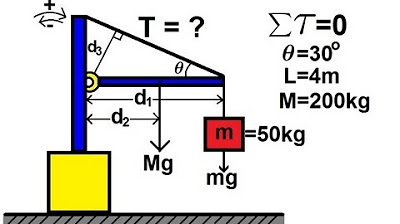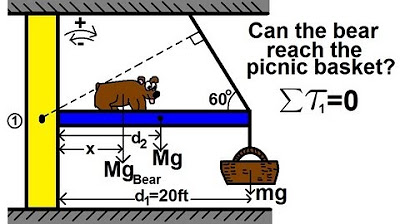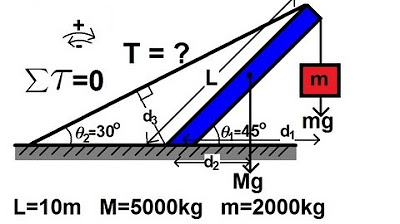Physics 15 Torque (4 of 27) Bar Held Up by Friction
TLDRThe video script presents a physics problem involving a beam held up by friction between it and a post, and a cable making a 20-degree angle with the horizontal. The beam supports another mass, M, at a distance, X, from the post. The challenge is to determine the minimum distance, X, required to prevent the beam from slipping. The solution involves calculating the tension in the cable, the normal force, and the friction force using trigonometric functions and the torque method. By setting the sum of torques to zero around a pivot point, the tension in the cable is expressed in terms of X. Finally, the friction force is calculated, and an equation is solved to find the critical distance, X, ensuring the beam does not slip. The process concludes with a numerical example, assuming specific values for the mass and length of the beam, leading to the minimum distance X in centimeters.
Takeaways
- 🔍 A beam is held up by friction against a vertical post and a cable at a 20-degree angle, supporting a suspended mass.
- 📐 The horizontal component of the cable's tension creates the normal force that results in friction between the beam and the post.
- 🧮 The friction force can be calculated using the normal force times the coefficient of friction (μ).
- 📐 The normal force is equal to the horizontal component of the tension (T_x), which is T times the cosine of the angle.
- ⚖️ The torque method is used to find the tension in the cable by considering the sum of all torques about a pivot point to be zero.
- 📏 The distance from the line of action of the force to the pivot point (d1 and d2) is crucial for calculating torques.
- 🔢 The length of the beam (L) and the distance of the suspended mass from the post (X) are used to calculate the tension in the cable.
- 🤔 The minimum distance (X) at which the beam will not slip is found by balancing the torques caused by the weight of the beam, the suspended mass, and the friction force.
- 📉 As the suspended mass is moved closer to the post, the likelihood of the beam slipping increases due to the increased force pulling it down.
- 📚 The coefficient of friction (μ) is a key factor in determining the friction force and thus the stability of the beam.
- 📐 The sine and cosine of the angle (20 degrees) are used in the equations to find the components of the tension and the friction force.
Q & A
What is the main problem being discussed in the script?
-The script discusses a problem involving a beam supported by friction against a post and a cable at an angle. The challenge is to find the minimum distance, denoted as X, that a suspended mass can be from the post without causing the beam to slip.
What force prevents the beam from slipping down?
-The force that prevents the beam from slipping down is the frictional force between the beam and the post, which is generated by the horizontal component of the tension in the cable.
How is the friction force calculated in this scenario?
-The friction force is calculated as the product of the normal force (which is equal to T sub X, the horizontal component of the tension in the string) and the coefficient of friction (mu).
What is the role of the torque method in solving this problem?
-The torque method is used to find the tension in the cable. By setting the sum of all torques around a pivot point to zero, one can solve for the unknown tension, which is necessary to calculate the friction force.
How is the tension in the cable related to the angle made by the cable with the horizontal?
-The tension in the cable can be found using trigonometry. Specifically, the horizontal component of the tension (T sub X) is found using the cosine of the angle (20 degrees in this case), and the vertical component (T sub Y) is found using the sine of the angle.
What is the significance of the mass M being moved back and forth?
-Moving the mass M back and forth changes the force acting on the beam. The farther the mass is from the post, the less the force pulling down on the beam, which reduces the likelihood of slipping. Conversely, moving the mass closer increases the force and the likelihood of slipping.
What is the formula for calculating the friction force in terms of the tension in the cable?
-The friction force is calculated as the tension times the cosine of the angle (20 degrees) times the coefficient of friction (mu).
How is the minimum distance X found?
-The minimum distance X is found by setting up an equation where the sum of all torques about a certain pivot point equals zero, and solving for X, which represents the distance from the post at which the beam will not slip.
What are the units of the final answer for the minimum distance X?
-The final answer for the minimum distance X is given in meters, and then converted to centimeters for a more precise measurement.
What is the value of the coefficient of friction (mu) used in the script?
-The coefficient of friction (mu) used in the script is 0.5.
What is the length of the beam (L) used in the numerical example?
-In the numerical example, the length of the beam (L) is initially considered to be 10 meters but is later simplified to 1 meter for ease of calculation.
What is the weight of the beam and the suspended mass, denoted as mg, in the numerical example?
-In the numerical example, the weight of the beam and the suspended mass (mg) is given as 100 Newtons.
Outlines
🔍 Introduction to the Beam and Friction Problem
The video begins with an introduction to a physics problem involving a beam supported by friction against a post and a cable at a 20-degree angle. The beam has mass M and supports another mass M at a distance X from the post. The goal is to determine the minimum distance X that prevents the beam from slipping. The frictional force is explained as being caused by the horizontal component of the tension in the cable, which is then broken down into components and related to the normal force. The video outlines the need to calculate the tension in the cable using the torque method, with the pivot point chosen to balance the torques from the forces acting on the system.
📐 Calculating Tension and Friction Force
The second paragraph delves into the calculation of the tension in the cable and the subsequent friction force. It explains that the tension can be found using the torque about a pivot point and that the friction force is the product of the normal force and the coefficient of friction. The normal force is identified as the horizontal component of the tension (T sub X), which is then used to calculate the friction force using the cosine of the 20-degree angle. The tension in the cable is expressed in terms of X, and the relationship between the forces and distances involved is developed into an equation that will be used to solve for X.
🔢 Solving for the Minimum Distance X
The final paragraph involves plugging in numerical values to solve for the minimum distance X that keeps the beam from slipping. It assumes the weight of the masses (mg) is 100 Newtons and the length of the beam (L) is 1 meter for simplicity. The forces and torques are analyzed around a second pivot point (point B) to ensure the friction force is sufficient to prevent slipping. The resulting equation is solved for X, which turns out to be 20.7 centimeters. This distance is identified as the closest the second mass can be to the post without the beam slipping, thus completing the problem's solution.
Mindmap
Keywords
💡Friction
💡Tension
💡Normal Force
💡Coefficient of Friction (μ)
💡Torque
💡Pivot Point
💡Equilibrium
💡Beam
💡Suspended Mass (M)
💡Distance X
💡Static Equilibrium
Highlights
The problem involves finding the minimum distance X to prevent a beam from slipping down due to friction
The beam is supported by a cable making a 20 degree angle with the horizontal
The beam has mass M and supports another mass M at a distance X from the post
The horizontal component of the cable tension pushes the beam against the post, creating friction
The friction force is the normal force times the coefficient of friction
The normal force is equal to the horizontal component of the cable tension
The horizontal tension component can be found using the cosine of the 20 degree angle
The torque method is used to find the tension in the cable
The sum of all torques about a pivot point equals zero
The torques are caused by the hanging mass, the beam's weight, and the cable tension
The center of mass of the beam is found to be at its halfway point
The perpendicular distance from the cable tension to the pivot point is found using sine
The cable tension is expressed in terms of X using the mass, distance, and angle
The friction force is calculated as the tension times cosine of 20 degrees times the coefficient of friction
A pivot point is chosen on the other side to find the minimum friction force needed to prevent slipping
The sum of torques about the new pivot point equals zero, with terms for the hanging mass, beam weight, and friction force
The equation is solved for the minimum distance X, which is found to be 20.7 cm
If the mass is moved closer than 20.7 cm, the beam will slip; if farther, the friction will hold the beam up
Transcripts
Browse More Related Video

Physics 15 Torque Example 1 (1 of 7) Mass on Rod and Cable

Physics 15 Torque (19 of 25) More Examples: 1 T=? of Cable Holding Fish

Physics 15 Torque (3 of 27) Tension=? in the Cable

Physics 15 Torque Example 6 (6 of 7) The Hungry Bear on a Beam; Tension in the Cable

Physics 15 Torque Fundamentals (8 of 13) How to Calculate a Torque (Basic Example 2)

Physics 15 Torque Example 3 (3 of 7) Mass on Rod and Cable
5.0 / 5 (0 votes)
Thanks for rating: